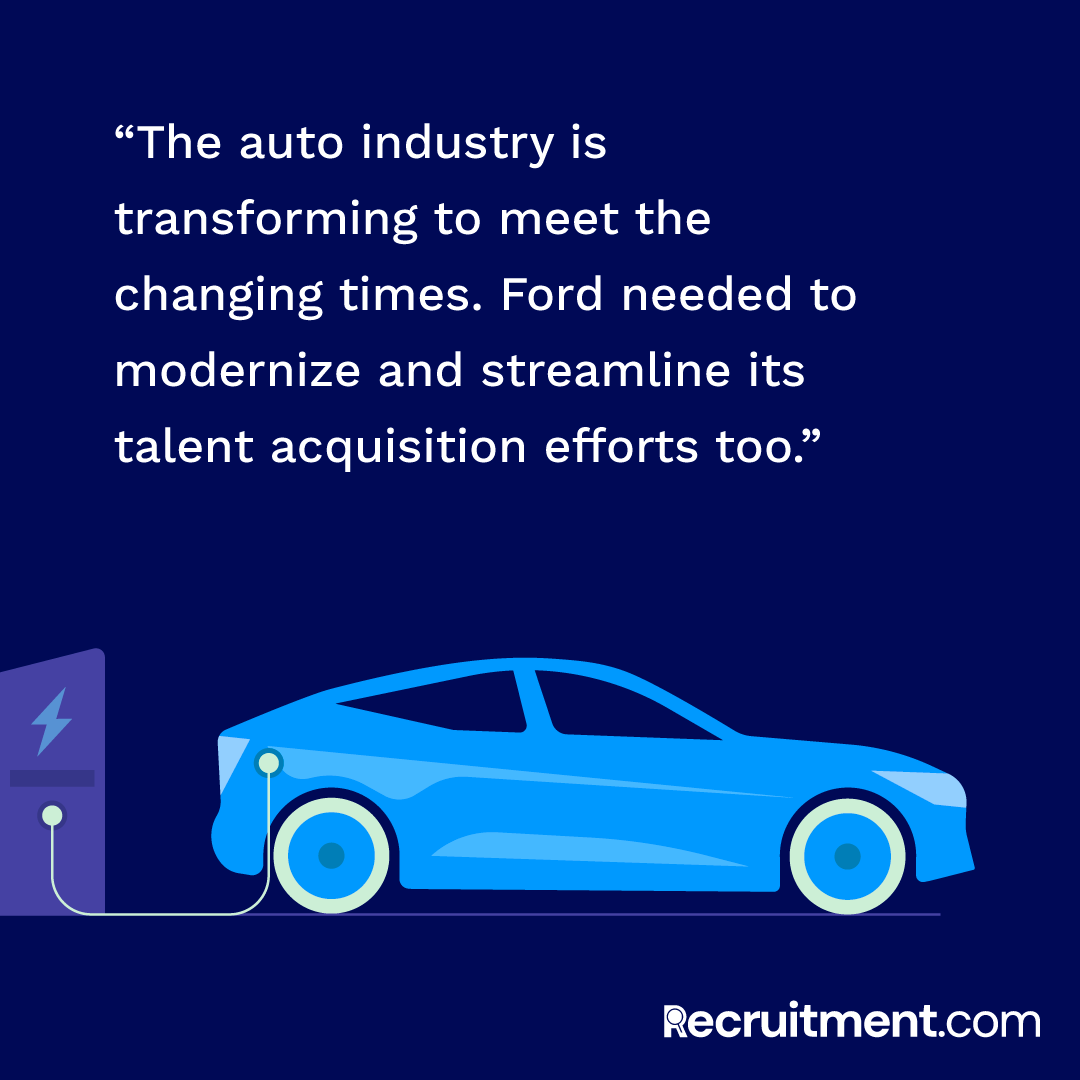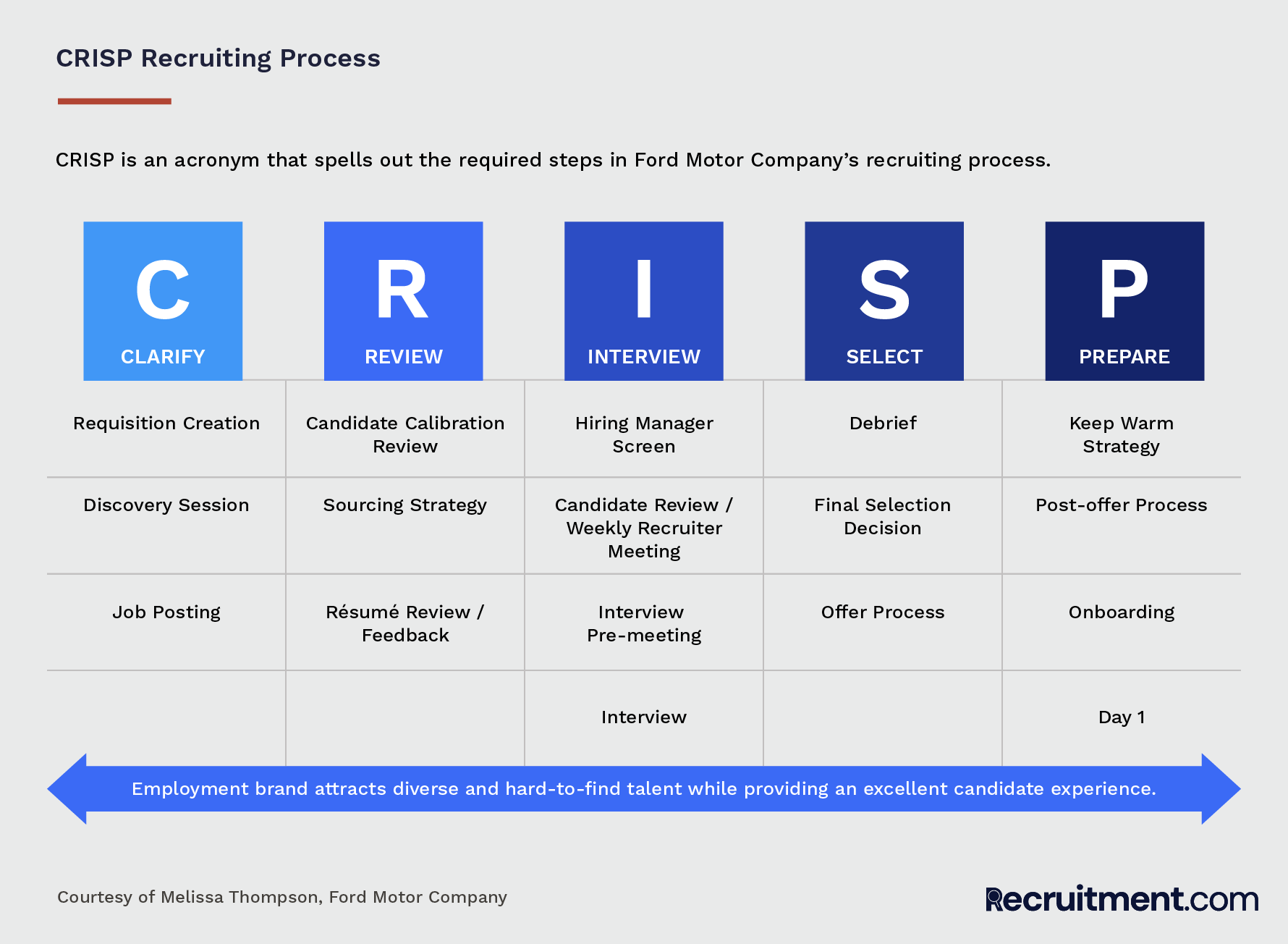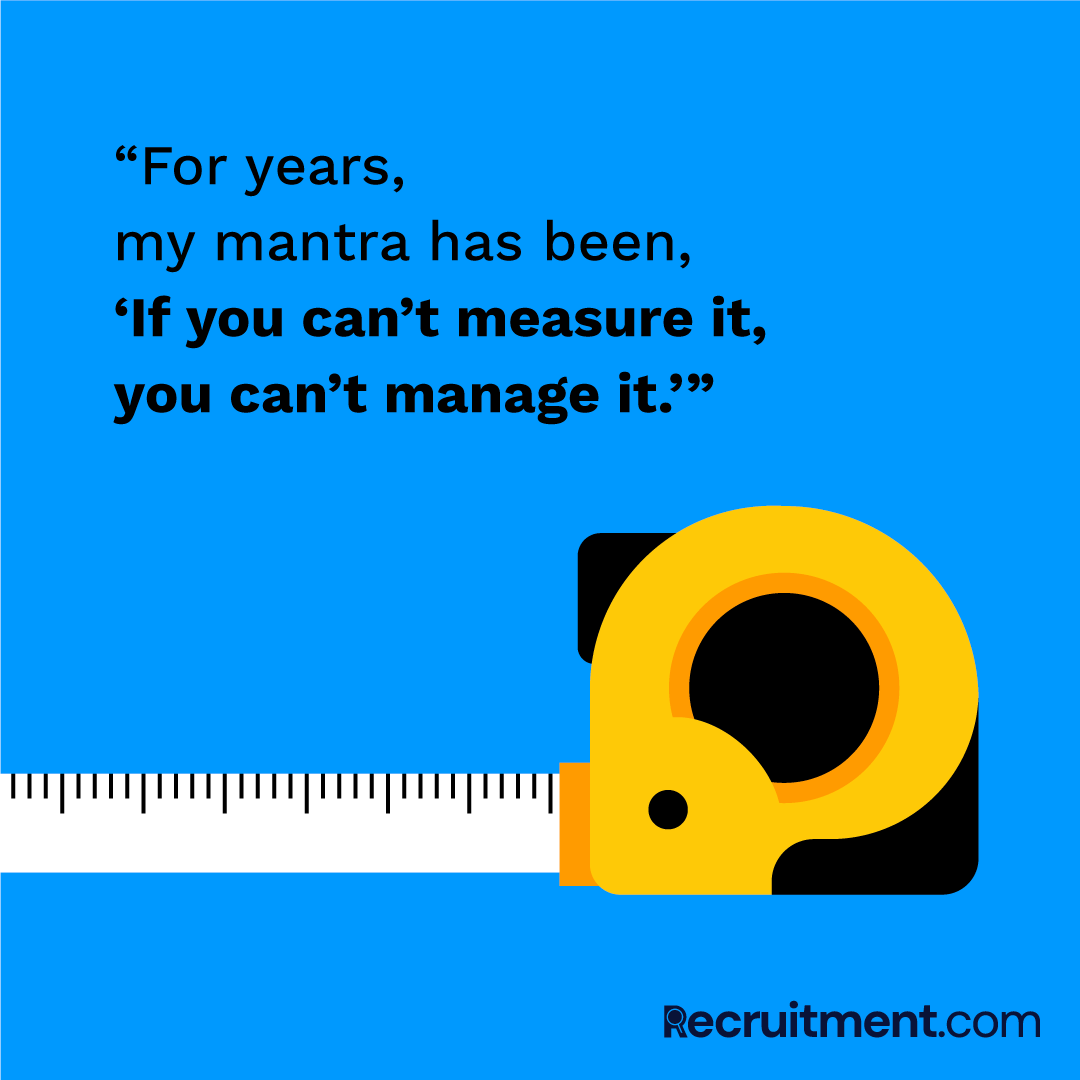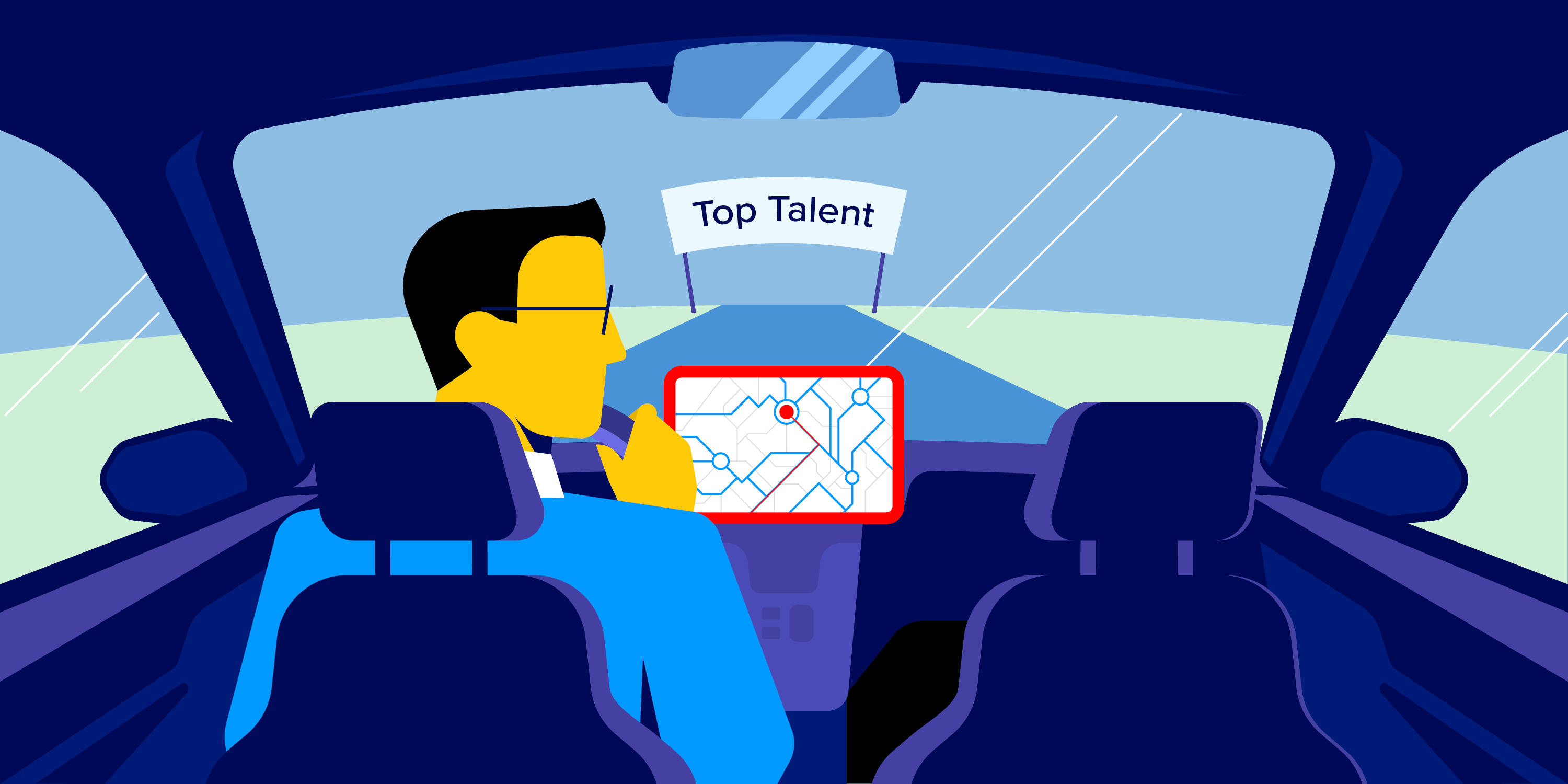Recruiting at Ford: Driving Talent Acquisition Through Operational Excellence

Melissa Thompson is the Global Head of Talent Acquisition for Ford Motor Company. She has previously held talent acquisition roles at Nielsen, McGraw-Hill Education, Bank of America, and Dell Computer Corporation.
Need to update your recruiting strategy? Ford’s head of talent acquisition says don’t be afraid to rethink it from the ground up.
I joined Ford Motor Company in 2021 as the first Global Head of Talent Acquisition. At that time, the iconic corporation utilized regional talent acquisition leaders to recruit for our team of more than 183,000 employees across three geographic regions. I quickly realized that Ford’s talent acquisition function needed a more cohesive, strategic, and scalable model to successfully navigate the changing automobile industry.
According to Reuters, by 2029, electric vehicles (EVs) could account for about 26% of cars produced worldwide and about a third of the North American market. At Ford, we plan to produce more than two million EVs annually and generate a 10% operating profit margin by 2026.
With those metrics in mind, Ford needed to modernize and streamline its talent acquisition function in order to attract the talent that could help us achieve our aggressive goals. I knew my experience optimizing talent acquisition strategies at other well-established companies—from Nielsen and McGraw-Hill Education to Citrix and Lenovo—would lend itself to the task of transforming talent acquisition at Ford.

In assessing Ford’s talent acquisition strategy, I was surprised to discover a lack of focus on operational excellence. To develop a recruiting model that ensured our day-to-day processes aligned with our overall business objectives, I asked myself these questions:
- Do we have what we need to ensure Ford is attracting and hiring the best talent in the market?
- Do our recruiters and hiring managers have an effective partnership?
- Do we have the right systems in place to deliver a best-in-class candidate experience?
I have used the following actionable tips to guide the transformation of talent acquisition at Ford.
Find Out What’s Working in Your Current Talent Acquisition Strategy—and What’s Not
Before I came on board, Ford had disparate recruiting teams and regional talent acquisition leaders, but no single global talent acquisition lead with the vision to drive a strategic transformation. This is the way the company had operated for decades. To successfully change the company’s talent acquisition strategy, I needed to build rapport and trust at all levels of HR, understand the specific needs and goals of the business, and identify the challenges our team members faced.
I spent my first three months on the job conducting a comprehensive “listening tour” to connect with stakeholders in a variety of positions across the business. I also spent a great deal of time having one-on-one conversations and hosting focus groups across divisions to collect information about the company’s recruitment needs, strengths, and possible areas of improvement. Some of my key questions included:
- What works in our recruitment process, and what doesn’t?
- What would you like to see change in the process in the next year?
- What does a successful talent acquisition strategy look like to you?
Gathering the responses to these questions was imperative, but equally important was reflecting back to my colleagues what I heard them say. To build trust and ensure that I understood their feedback, I summarized and shared my findings following each session. I also provided an outline of next steps. This two-way communication helped build rapport and establish a partnership.
Conducting a listening tour at the beginning of any talent strategy transformation provides invaluable feedback from key stakeholders at your company. That information provides a starting point for developing an action plan and concrete examples to help your team pivot.
Streamline the Recruitment Process
As with any major corporation, Ford had a talent acquisition process in place when I arrived. But it was cumbersome and lacked role clarity for both recruiters and hiring managers.
To drive the transformation, we trained recruiters on a process model I developed called CRISP: Clarify, Review, Interview, Select, and Prepare. The model outlines the required steps in our recruiting process, from job requisition to onboarding.

We also introduced a new internal training program for hiring managers called Winning Talent. The program outlines the hiring managers’ role in the recruiting process, from opening their network to recruiters, to interviewing and closing the final candidate. It encourages managers to partner with their recruiters and take an active role in the hiring process. It’s a bit like that Jerry Maguire quote: “Help me help you.” I originally designed Winning Talent under a different name at Citrix, and, based on the success of the program, revised it for Ford with help from an external consultant.
Once the recruiters and hiring managers were properly trained on the CRISP model and Winning Talent, they became better partners in the process. By ensuring each player understood their role and the steps involved, we’ve been able to unravel and simplify the talent acquisition process.
Examine Recruiting Data and Analytics
For years, my mantra has been, “If you can’t measure it, you can’t manage it.” Data associated with key activities in the recruiting process can help measure the success of your team. For example, requisition volume and time to fill a vacancy can tell us if we have the right number of talent acquisition resources in place or if we are using the appropriate sourcing channels.
Successful talent acquisition organizations need to measure data related to the activities of recruiters, hiring managers, and candidates, covering the process from requisition creation to a new hire’s first day. For instance, we need to see the number of requisitions we have open at any one time and the status of those openings, how many days it takes to fill a position, and the number of days from application to offer acceptance. We analyze and compare the data across business divisions and develop early warning systems for aging requisitions.
In October 2022, Ford implemented a new applicant tracking system (ATS) called Oracle Recruiting. We can analyze and compare data pulled from the ATS to identify trends. For example, a simple “red, yellow, green” status assigned to a requisition will provide recruiting managers with a quick snapshot of its status and offer updates to business leaders.
To supplement our ATS and recruiting process, our talent acquisition operations team used Oracle Recruiting to launch surveys with hiring managers and candidates after the interview stage to see how both sides viewed the company’s process. The survey uses both a net promoter score and verbatim feedback to identify key opportunities for process improvement. We engage our stakeholders such as HR, hiring managers, and business leaders to help develop action plans and provide solutions.
You need a combination of data and feedback to find the opportunities to adjust, redesign, or innovate your processes. Regular iteration and review of data will help you drive a game-changing talent acquisition team.

Evangelize Employer Branding
While Ford enjoys a world-renowned commercial brand, our employer brand is relatively unknown. To develop it, we needed to understand what attracted candidates to Ford. We used the insights we gained from the listening tours and data gathering to translate the power of our larger brand into a compelling message that would motivate candidates to consider opportunities at Ford.
For example, Ford boasts an impressive amount of technology in developing our automobiles. While names like Tesla, Toyota, and GM—as well as tech giants like Google and Apple—have become synonymous with pioneering efforts in the mobility industry, Ford is a leader in the automotive technology space and we’re focused on making this known.
To help spread the message of our employer brand, we attended the most recent annual Grace Hopper Celebration, which brings together around 30,000 female and nonbinary technologists from around the globe, to discuss their research and career interests in the computing world. While there, we introduced thousands of people to our electric vehicles, including the hardware and software behind them. Ford’s participation clearly illustrated our company’s need for the right technology talent and allowed us to speak directly to the professionals who have the skills necessary to take on the challenge.
Even if you have the best possible message, it will only benefit your company if you effectively spread the word about your employer brand. In 2022, our talent team introduced an employee ambassador program that encourages employees to like and share posts that help communicate the brand beyond our own walls. To that end, we also attach 90-second videos to job postings explaining why candidates should consider applying, and post regularly on LinkedIn as a way to tell our story. In so many ways, recruiting depends on marketing, and you have to use today’s most powerful talent acquisition tools, like social media, to build awareness and to attract and retain the best talent around.
We are in the first stage of our talent acquisition transformation at Ford. This gives us time to get the necessary changes in place and let those changes work for a while before we move on to the next phase: innovation. Right now, it’s all about listening, research, and analytics—together, they create a solid foundation that can drive Ford toward the next step of our talent transformation journey.

Melissa Thompson is the Global Head of Talent Acquisition for Ford Motor Company. She has previously held talent acquisition roles at Nielsen, McGraw-Hill Education, Bank of America, and Dell Computer Corporation.



